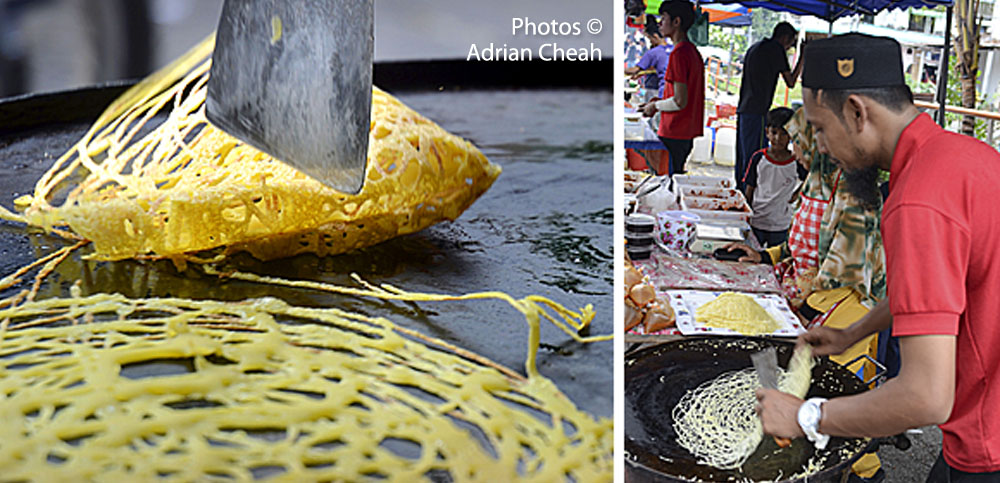Roti Jala (net crepes) are simply irresistible with curry chicken and potatoes

If you are a tourist in Penang during Ramadhan, you have to add the Ramadhan bazaar to your list of must-see places. The month-long Ramadhan bazaar (opens from 3:30 – 7:30 pm) offers a wide variety of Malay specialities and it is a wonderful market to scout for delicious treats. Roti Jala is something I will usually buy among many others.

"Roti" literally means "bread" in Malay and "jala" means "net". However, Roti Jala in Malaysia refers to the traditional Malay gossamer-like net crepe. The net-like pattern is obtained when thin streams of batter are poured in a circular motion over a hot pan. This dish is popular among the Peranakan Chinese community as well and in many aspects, it is quite similar to the Malay version.

My Mum, whom I adore dearly, is an amazing woman and a brilliant cook. Being in the kitchen with her at a young age, helping out when needed, has actually sharpened my culinary skills. She has taught me many useful tips that have become second nature when I am in the kitchen preparing a meal. Everything feels easy as if I am on autopilot mode; not much thought was necessarily given to knifework when preparing ingredients or cooking. It is like riding a bicycle – you remember everything when riding. Once I am in the kitchen, recognisable flavours and aromas guide me in preparing dishes the way Mum would.

Mum makes delicious Roti Jala, usually enjoyed with savoury curry chicken. She begins preparing the batter for Roti Jala by mixing flour, eggs, santan (coconut milk), water and a pinch of salt in a large bowl. The eggs provide a beautiful shade of pastel yellow to the batter and with a pinch of kunyit (turmeric) power, she would further enhance the colour. After mixing the batter well, Mum would sieve the batter into a clean bowl and cover it for 30 minutes before using it.
Some recipes would replace santan with full cream milk. Others would skip both santan and milk altogether. Try out a few recipes (plenty available on the internet) and decide on the one that suits you best.
What has changed is the way the batter is poured onto the frying pan to create the intricate lace doily pattern. In the good olde days, the rural folk along the coastal shores might have fashioned a device made up of a tempurong (coconut shell) which was easily available. Holes would have been drilled onto the shell to enable the batter to pass through. Much later, a condensed milk can with tiny holes poked through it would have been another alternative.

However, the inventive Nyonyas, who command perfection in everything they do, especially in cooking, must have persuaded their tin-smiths to fashion their Roti Jala cups. These cups were usually made of copper or brass and have four to six small funnels soldered to the base of each cup. These ingenious cups are convenient and easy to use, allowing better control of the flow of the batter, thus making more delicate patterns. Nowadays, plastic versions of the Roti Jala cups are available as well.

With a Roti Jala cup in hand and batter well-rested, Mum will then heat up a flat-based pan and lightly grease it with some cooking oil. On medium heat, she will move the cup in concentric circles, making intricate lacy patterns. A successful batter will enable thin continuous streams to flow from the cup. Thin the batter with santan if it is too thick or add some flour if it is runny.
Roti Jala is cooked on one side only and folded into a semicircle, then into a quarter and finally into one-eighth. She would line the plate with a banana leaf and place the cooked pieces on it. To prevent the Roti Jala from drying, she would cover them with a tea towel. There are other ways of folding the Roti Jala as well – into quarters, one-sixths or rolled up into cylinder tubes.
Roti Jala is best eaten with Nyonya curry chicken with potatoes or beef curry. My late Dad would usually purchase Roti Jala with kaya (coconut jam that is firm, almost like a cake) from the Ramadhan bazaar in Little India. It was my favourite when I was very young. Until today, enjoying Roti Jala and kaya brings back fond memories. Today, it is also easy to find Roti Jala rolls encased with spicy potato fillings at any Ramadhan bazaar.

Roti Jala is available throughout the year in Penang including at eateries in Little India and pasar malam (night markets). Search online for Persatuan Peniaga Melayu Pasar Malam Negeri Pulau Pinang (PPPMPP) for the locations of the night markets.
If you are living abroad or would like to make a batch at home, follow this simple recipe to make delectable Roti Jala. For the batter use 600 gms flour, ½ tsp salt, 6 eggs, 100 ml santan (coconut milk) or milk, 850 ml water and a pinch of turmeric powder for colouring. Always test its consistency, adjust the batter until you get continuous streams from the funnels. Happy cooking!
---------------------------------------------------------
Written and photographed by Adrian Cheah
© All rights reserved
Updated 30 May 2021